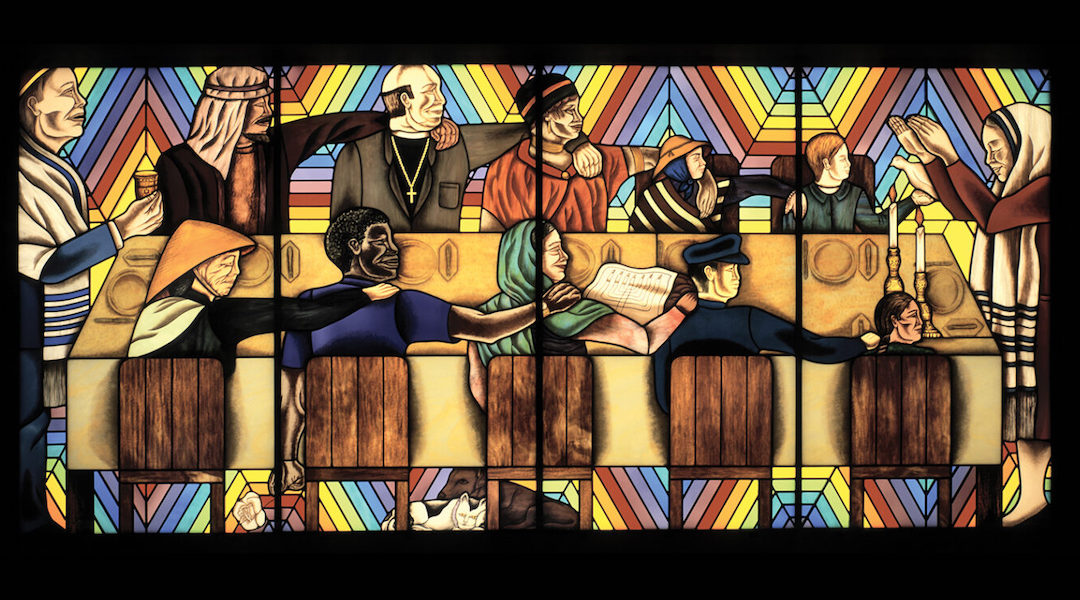(New York Jewish Week) — There is a scene currently playing out on Manhattan’s Lower East Side that might seem unimaginable in these fractured times.
A man and a woman, each draped in a Jewish prayer shawl, stand at each end of a long table. The man is holding a kiddush cup; the woman is blessing a pair of candles. Around the table sit men, women and children representing the world’s ethnicities and religions: a Christian clergyman wearing a cross, a Muslim man wearing a white keffiyeh, a Black woman in a red robe. Each of the guests has a hand draped over a seatmate’s shoulder.
It’s a huge stained glass panel by the feminist Jewish artist Judy Chicago, and it is one of the centerpieces of “Judy Chicago: Herstory” at the New Museum, the first comprehensive New York museum survey of the work of an artist active since the 1960s.
Chicago, a feminist icon, created “Rainbow Shabbat” in 1992 with her husband Donald Woodman as part of the “Holocaust Project: From Darkness into Light,” their multimedia exploration that toured museums beginning in 1993.
Originally intended as a hopeful climax to an exhibit about genocide, “Rainbow Shabbat” has taken on new meaning at the New Museum show, which opened days after the Hamas attack on Israel and the war that followed. (It closes March 3.) An optimistic viewer could see it as a vision of interfaith harmony that could yet be after the fighting stops; a pessimist might see it as naive or sadly ironic.
Chicago, however, remains an optimist. “The large, stained glass window uses the Friday night Jewish dinner as a metaphor for a world of global sharing, which is my fervent hope and the vision that animates my lifetime of work,” she wrote this month on Instagram, in a post marking the United Nation’s World Interfaith Harmony Week. “Here’s to a world illuminated by greater understanding and harmony.”
Chicago, born Judith Cohen in 1939 and descended from a long line of rabbis on her socialist father’s side, has said the image for “Rainbow Shabbat” came to her during a visit to Israel.
“There were 12 people there: men and women from four different countries, of different ages, and mostly strangers,” she wrote in the exhibition catalogue for “The Holocaust Project.” “We all went around the table and told stories, and everyone listened for hours. For me the evening brought up not just feelings about my childhood but also the incredibly warm moments Donald and I had shared with Jews around the world. Being welcomed into Jewish homes during our travels gave us a profound sense of a global community and provided me with an idea for the last image of the project, an image of optimism and hope.”
Chicago is best known for another work set around a table: “The Dinner Party” (1974–79), now on permanent display at the Brooklyn Museum, is a triangular installation with place settings for 39 mythical and historical women. “The Dinner Party” is now considered the most popular — and argued about — work of art to emerge from the second-wave feminist movement.
The New Museum exhibit demonstrates how Chicago’s feminism has long nested beside her Jewish identity. It includes work like her embroidered “What If Women Ruled the World?” banners, and her “Birth Project” series that celebrates women’s bodies, as well as images from the “Holocaust Project,” which merges her husband’s photography with her painting and stained glass. A work from her needlework series “Resolutions: A Stitch in Time,” also includes a piece with an interfaith message: 2000’s “Bury the Hatchet” depicts a Christian, a Jew and a Muslim doing just that.
In 2007, what is now the Dr. Bernard Heller Museum at New York’s Hebrew Union College-Jewish Institute of Religion presented “Judy Chicago: Jewish Identity,” featuring works that illustrated her Jewish themes.
“The art and archival documents on display reveal how the artist’s secular Jewish upbringing was deeply imbued with Jewish ethical values, particularly the concept of tikkun (the healing of the world) and the aspiration for social justice in our society,” Gail Levin, one of that show’s organizers and author of “Becoming Judy Chicago: A Biography of the Artist,” said at the time.
“Judy Chicago: Herstory” runs through March 3 at the New Museum (235 Bowery, Manhattan); newmuseum.org.
The New York Jewish Week brings you the stories behind the headlines, keeping you connected to Jewish life in New York. Help sustain the reporting you trust by donating today.





